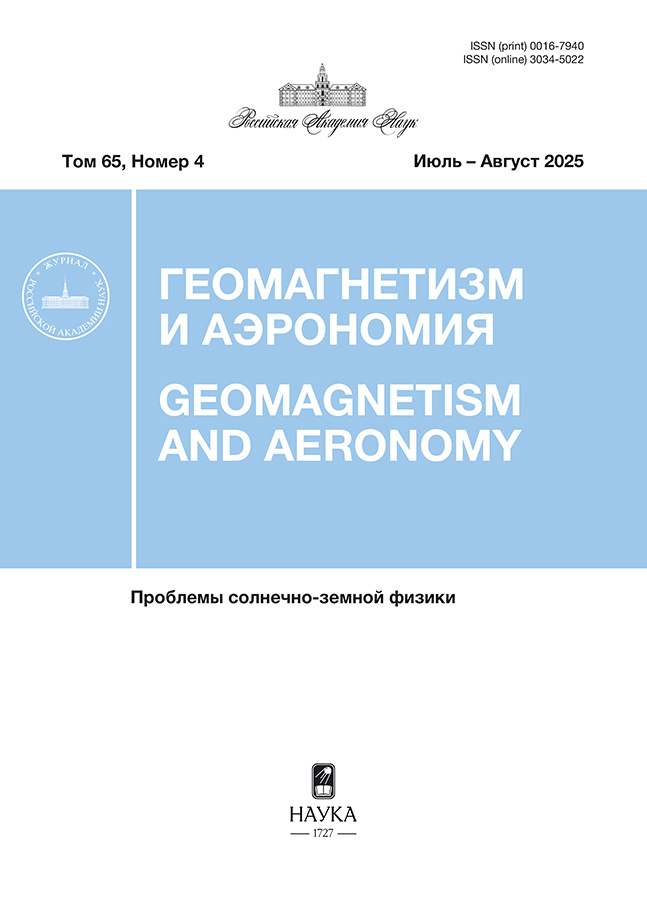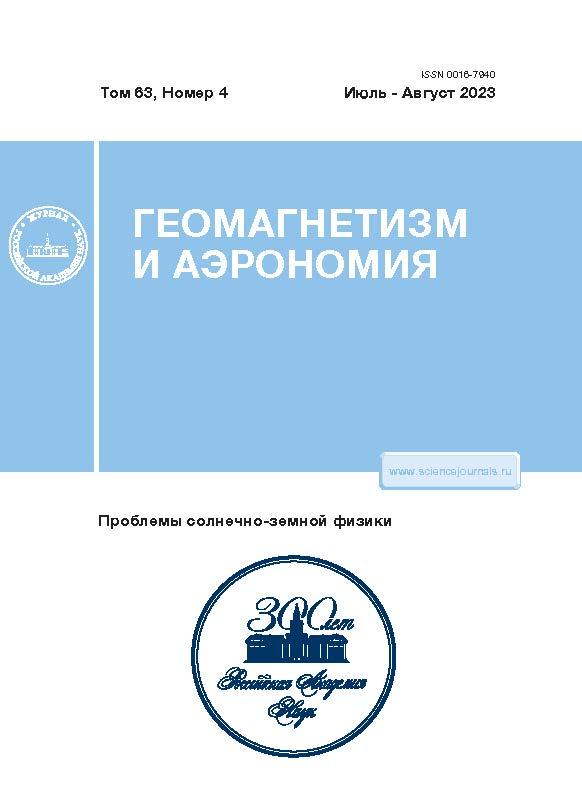Rotation of a Long-Lived Coronal Hole in Solar Cycle 24
- Authors: Andreeva O.A.1, Malaschuk V.M.1
-
Affiliations:
- Crimean Astrophysical Observatory, Russian Academy of Sciences
- Issue: Vol 63, No 4 (2023)
- Pages: 496-502
- Section: Articles
- URL: https://ruspoj.com/0016-7940/article/view/651003
- DOI: https://doi.org/10.31857/S0016794023600412
- EDN: https://elibrary.ru/OJWGVB
- ID: 651003
Cite item
Abstract
This paper discusses the results of a statistical study of the rotation characteristics of a long-lived
giant coronal hole. The study is based on observation data obtained by the Atmospheric Imaging Assembly
in the Fe XII 19.3 nm line aboard the Solar Dynamics Observatory spacecraft during the period from June
2015 to March 2017; this was 24 Carrington revolutions. Four stages of the development of a coronal hole are
considered separately: formation, two phases of a developed coronal hole, and the final phase. It has been
found that the average rotation rate at a latitude of 40° is close to the standard speed at the beginning
(12.75°/day) and in the first phase of maximum development (13°/day); it is lower in the second phase of
maximum development (11.7°/day) and at the end of its existence (12.5°/day). A slight increase in velocity at
the final stage is associated with the restructuring of the coronal hole. According to modern theories, the rotation
of the solar corona reflects the rotation of the subphotospheric layers. The higher layers of the corona
reflect the rotation of the deeper layers of the Sun. The results obtained in our work show that the rotation
rate of a giant coronal hole in the maximum phase of its development is greater than the rotation rate of the
solar disk. Perhaps this indicates that coronal holes can be associated with deep solar layers through the configuration
of the global magnetic field and that the source of coronal hole formation is deeper than the source
of the background field.
About the authors
O. A. Andreeva
Crimean Astrophysical Observatory, Russian Academy of Sciences
Email: olga@craocrimea.ru
Crimea, 298409 Russia
V. M. Malaschuk
Crimean Astrophysical Observatory, Russian Academy of Sciences
Author for correspondence.
Email: mvm@craocrimea.ru
Crimea, 298409 Russia
References
- − Андреева О.А., Малащук В.М., Ахтемов З.С., Жигалкин Р.К. Изменение площади и интенсивности гигантской корональной дыры // Изв. Крымск. Астрофиз. обс. Т. 114. № 1. С. 129–134. 2018.
- − Ахтемов З.С., Перебейнос В.А., Штерцер Н.И. Гигантская корональная дыра 2015–2017 гг.: II магнитное поле и связь с активными образованиями // Изв. Крымской Астрофиз. обс. Т. 114. № 1. С. 123–128. 2018.
- − Бадалян О.Г., Обридко В.Н., Сикора Ю. Циклические вариации дифференциального вращения солнечной короны //Астрономический журн. Т. 83. № 4. С. 352–367. 2006.
- − Andreeva O.A., Akhtemov Z.S., Malashchuk V.M., Zhigalkin R.K. Study of Variations of Some Characteristics of the Giant Coronal Hole of 2015–2017 //Geomagnetism and Aeronomy. V. 58. № 8. P. 916–924. 2018.
- − Andreeva O.A., Malashchuk V.M. The changing in the vertical boundaries of a giant coronal hole // AApTr, V. 31. № 2. P. 209–216. 2019.
- − Bagashvili S.R., Shergelashvili B.M., Japaridze D.R. et al. Statistical properties of coronal hole rotation rates: Are they linked to the solar interior? // Astron Astrophys V. 603:A134. 2017. https://doi.org/10.1051/0004-6361/201630377
- − Benevolenskaya E.E., Kosovichev A.G., Scherrer P.H. Detection of high-latitude waves of solar coronal activity in extreme-ultraviolet data from the solar and heliospheric observatory EUV imaging telescope // Astrophys. J. V. 554. P. 107–110. 2001.
- − Cranmer S.R. // Living Rev. in Sol. Phys. V. 6. 3. 2009. https://doi.org/10.12942/lrsp-2009-3
- − Glencross W.M. Formation of holes in the solar corona // Nature V. 250. P. 717–719. 1974.
- − Hiremath K.M., Hegde M. Rotation rates of coronal holes and their probable anchronic depts // ApJ. V. 763. № 2. P. 137–148. 2013.
- − Hiremath K.M., Hegde M., Varsha K.R. Rotation rate of high latitude and near polar coronal holes. 2022. https://doi.org/10.48550/arXiv.2204.04193
- − Insley J.E., Moore V., Harrison R.A. The differential rotation of the corona as indicated by coronal holes // Sol. Phys. V. 160. P. 1–18. 1995.
- − Japaridze D.R., Bagashvili S.R., Shergelasvili B.M., Chargeishvili B.B. Investigation of Solar Rotation Using Coronal Holes // Astrophysics. V. 58. P. 575–579. 2015.
- − Krieger A.S., Timothy A.F., Roelof E.C. A coronal hole and its identification as the source of a high velocity solar wind stream // Sol. Phys., V. 29. P. 505–525. 1973.
- − Larson T.P., Schou J. Global-Mode Analysis of Full-Disk Data from the Michelson Doppler Imager and the Helioseismic and Magnetic Imager // Solar Phys. V. 293. P. 2–29. 2018. https://doi.org/10.1007/s11207-017-1201-5
- − Mancuso S., Giordano S. Differential rotation of the ultraviolet corona at solar maximum // Astrophys. J. V. 729. P. 79–86. 2011.
- − Navarro-Peralta P., Sanchez-Ibarra A. An observational study of coronal hole rotation over the sunspot cycle // Solar Phys. V. 153. P. 169–178. 1994.
- − Obridko V.N., Shelting B.D. Coronal holes as indicators of large-scale magnetic fields in the corona // Sol. Phys. V. 124. 73–80. 1989.
- − Oghrapishvili N. B., Bagashvili S.R., Maghradze D.A. et al. Study of the solar coronal hole rotation. // Advances in Space Research. V. 61. № 12. P. 3039–3050. 2018.
- − Prabhu K., Ravindra B., Manjunath Hegde, Vijayakumar H. Doddamani. Recurring coronal holes and their rotation rates during the solar cycles 22–24 // Astrophys. Space Sci. V. 363. P. 108–118. 2018.
- − Shelke R.N., Pande M.C. Differential rotation of coronal holes // Solar Phys. V. 95. P. 193–197. 1985.
- − Stepanian N.N., Andryeyeva O.A., Zyelyk Ya.I. Rotation of Solar Structures in the Upper Chromosphere. II. Time Variations in the Latitudinal Distribution of the Rotation of Active Regions and Coronal Holes // Bull. of the Crimean Astrophys. Obs. V. 103. № 1. P. 48–62. 2007.
- − Timothy A.F., Krieger A.S., Vaiana G.S. The structure and evolution of coronal holes //Sol. Phys. V. 42. P. 135–156. 1975.
- − Tousey R., Bartoe J.D.F., Bohlin J.D. et al. A preliminary study of the Extreme Ultraviolet spectroheliograms from Skylab // Sol. Phys. 33. P. 265–280. 1973. 1985.
- − Wagner W.J. Solar rotation as marked by extreme-ultraviolet coronal holes // Astrophys. J. Lett. V. 198. L141. 1975. https://doi.org/10.1007/s10509-018-3307-0
- − Wagner W.J. Rotational characteristics of coronal holes: In: Bumba, V., Kleczek, J. (eds.) // Basic Mechanisms of Solar Activity. IAU Symposium. V. 71. P. 41–45. 1976.
Supplementary files

















